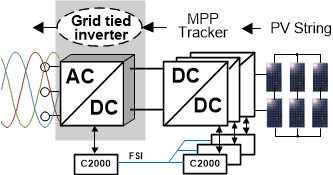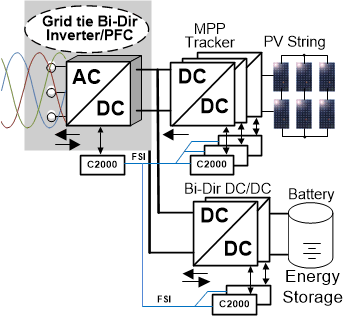SPRACR6 April 2020 F29H850TU , F29H859TU-Q1 , TMS320F280023-Q1 , TMS320F280023C , TMS320F280025C , TMS320F280025C-Q1 , TMS320F280041-Q1 , TMS320F280041C , TMS320F280041C-Q1 , TMS320F280048-Q1 , TMS320F280048C-Q1 , TMS320F280049-Q1 , TMS320F280049C , TMS320F280049C-Q1 , TMS320F28384D , TMS320F28384D-Q1 , TMS320F28384S , TMS320F28384S-Q1 , TMS320F28386D , TMS320F28386D-Q1 , TMS320F28386S , TMS320F28386S-Q1 , TMS320F28388D , TMS320F28388S , TMS320F28P650DH , TMS320F28P650DK , TMS320F28P650SH , TMS320F28P650SK , TMS320F28P659DH-Q1 , TMS320F28P659DK-Q1 , TMS320F28P659SH-Q1
2.1 Distributed Power Control Architecture – DC/AC System
The first DPCA application is illustrated in Figure 1. This is the C2000 MCU-based solar string inverter DPCA system where the photovoltaic (PV) string output is processed through a MPPT DC/DC converter and then applied to the DC/AC inverter inputs. The inverter finally delivers power to the grid. As indicated in Figure 1, all DC/DC and DC/AC power conversion stages are controlled by multiple C2000 MCUs. A key feature of such PV system is the efficiency of conversion at which the power converter stage can extract the energy from the PV arrays and deliver to the load. The maximum power point tracking (MPPT) of the PV output for all sunshine condition allows reduction of the cost of installation and maximizes the power output from the PV panel. Therefore, the DC-DC converter employs some MPPT algorithm to efficiently extract the PV output power and convert the PV output voltage to a high voltage DC bus. The converter draws dc current from the PV panel such that the panel operates at its maximum power transfer point. This requires maintaining the panel output, such that, the DC-DC converter input at a level determined by the MPPT algorithm. The DC-DC converter, depending on the system requirement, can use either an isolated power stage or a non-isolated stage. This is most frequently implemented using an interleaved boost or multi-level boost converter stage. The high voltage bus from the DC-DC converter is then used to power the DC-AC inverter that eventually supplies the load and connects to the grid. Depending on the power level of the string inverter the MPPT DC/DC could consists of multiple power stages controlled by multiple C2000 MCUs. Then all of the MCUs, as indicated in Figure 1, could be connected through the high-speed FSI ports for exchange of information between the DC/DC and the DC/AC stages. This exchange of information could be anything related to closed loop control, system parameter monitoring and other system level management functions needed to support the proper operation of this solar inverter DPCA system.
 Figure 1. Solar String Inverter in a DPCA Configuration
Figure 1. Solar String Inverter in a DPCA Configuration Figure 2 shows the same solar string inverter DPCA system as in Figure 1 with the added energy storage feature. This makes it an energy storage system (ESS). All DC/DC and DC/AC power conversion stages are controlled by multiple C2000 MCUs. For the ESS with string inverter, the grid-tie converter indicated in Figure 2 needs to be bi-directional. Also a second bi-directional DC/DC is needed between the energy storage device, such that, the battery, and the high voltage DC bus. Here again, based on the power level of the ESS, the DC/DC could consists of multiple power stages controlled by multiple C2000 MCUs and then all the MCUs could be connected through the FSI ports for overall system control and management.
 Figure 2. Solar String Inverter With Energy Storage in a DPCA Configuration
Figure 2. Solar String Inverter With Energy Storage in a DPCA Configuration